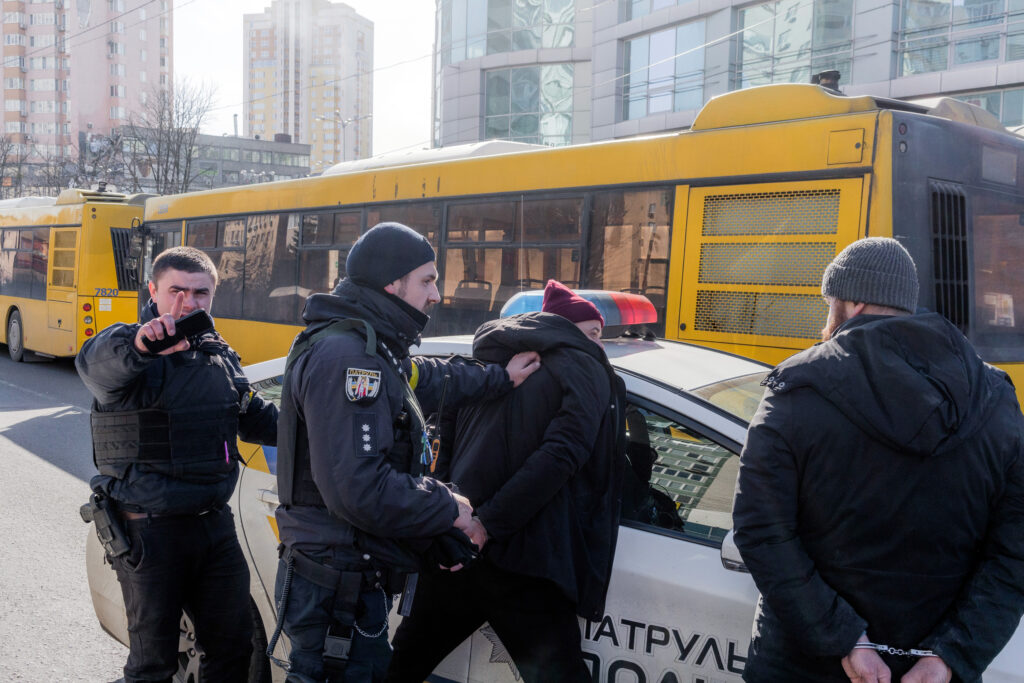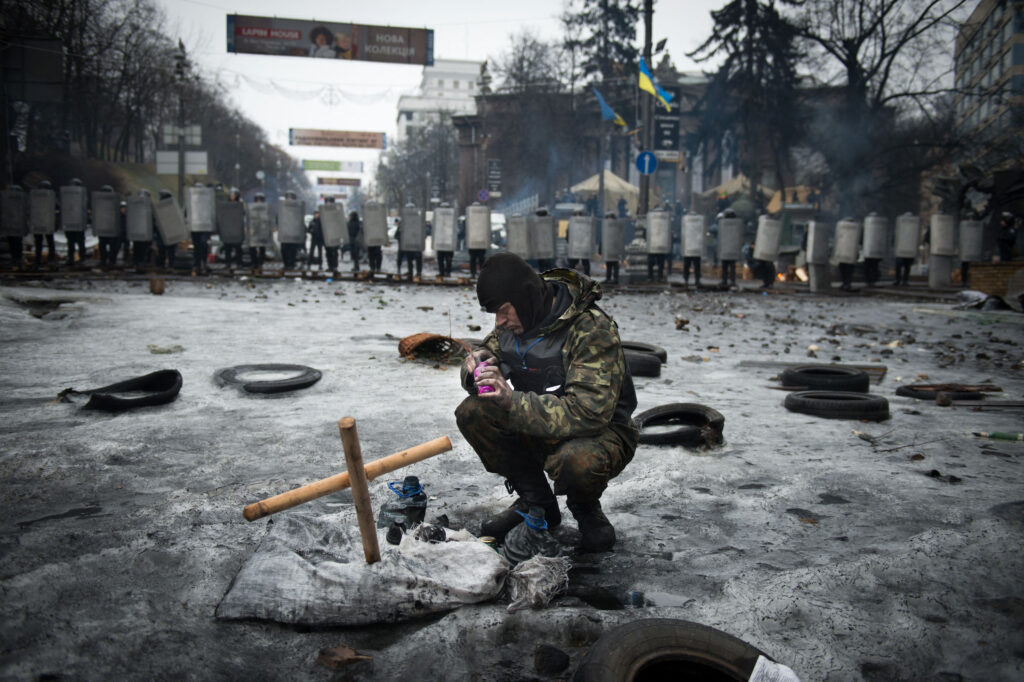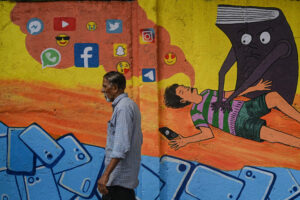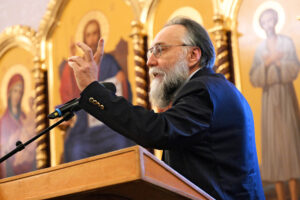Darkness on the Edge of Ukraine

In late September, while President Volodymyr Zelensky was presenting his “victory plan” for Ukraine in Washington, 53-year-old Serhiy Kanalosh was dying in a hospital after four days spent at a mobilization center in Svaliava, western Ukraine. His wife says he was beaten to death; it is not clear by whom exactly.
Late last month, an unidentified serviceman killed 40-year-old Yevhen Kryvodub in another mobilization center, this one in Sumy, northern Ukraine. Several such deaths have been reported over the past year, amid a government campaign forcibly rounding up draftees to replenish the shrinking force that is fighting against Russia.
Mobilization officers and their proxies have been grabbing and beating up men in the street throughout Ukraine. Videos of such scenes pop up regularly—daily, it seems—on Telegram channels. I’ve watched hundreds.
One clip shows mobilization officials dragging a driver out of a tram full of passengers in Odesa. In another, shot in Mykolaiv in mid-October, four men in fatigues choke a man lying on the asphalt, George Floyd–style. Scores of such videos emerged online this past fall, after the authorities started launching sweeping raids of shopping and entertainment facilities across the country, including at a concert of Ukraine’s most famous rock band, Okean Elzy. Some footage shows bystanders actively defending the detainees and occasionally rescuing them. In one video from the southwestern region of Zakarpattia, a group of women can be seen hurling stones at a press gang’s minivan.
The acts in such scenes, which thousands of Ukrainians have witnessed, are popularly known as “busification”—after the mini-buses used by mobilization authorities to transport the men they catch. “Busification” was declared the Ukrainian word of the year 2024 by myslovo.com, a portal promoting the language.
In response to public outrage over these methods, Defense Minister Rustem Umerov acknowledged in November that they raised “painful issues for the population” and promised that the government would avoid forced conscription in the future.
The Ukrainian authorities often validate the authenticity of these videos—if only by prosecuting people who film them and share them on social networks. In October, a man in Odesa received a suspended five-year sentence for “circulating data threatening national security” after he posted a TikTok video showing a scene of mobilization. In a Telegram post from November 15, a “volunteer” (a government euphemism for a hired thug) working with mobilization authorities is seen shooting from a pistol in the direction of a fleeing man in a parking lot in the Kyiv region. (The incident was confirmed by the authorities, but they claimed the shots were fired in the air.)
Because each one of these videos is about the story of the life and the very possible death of a specific individual, I find them even more heartbreaking than the aerial shots of ruined cities and villages in Ukraine. I imagine that the life expectancy of hastily mobilized and barely trained draftees probably is just days if they are sent in the trenches. Many choose to desert at the first opportunity.
So what are all these people dying, or suffering, for—when it’s not out of patriotic fervor and quite obviously against their will? What is the grand purpose of making millions live in constant fear of being dragged away from the street and sent to their death, sometimes even before reaching the frontline?
Ukraine has lost most of its energy infrastructure and nearly 20 percent of its land since 2014, much of it after Russia’s full-on invasion in February 2022. Several million of its people have fled abroad looking for refuge and are unlikely to come back. What will this sacrifice have been for?
These are questions that Ukrainians are going to be asking once an uneasy compromise with Russia is finally reached and the war is over. And all the more so because this conflict could have ended earlier and before hundreds of thousands lost their lives on the frontline: during the talks in Istanbul in the spring of 2022—or when Zelensky and Vladimir Putin met in Paris in 2019, or earlier still, under the Minsk agreements of 2014–15.
Even before Donald Trump’s victory in the US presidential election in November, a pivot toward finding a peaceful resolution of the Ukrainian conflict had become the apparent priority in various quarters (the German chancellor Olaf Scholz is a good example). The fate of Ukraine was sealed long ago. Officials in western Europe and Poland, one of Ukraine’s staunchest allies, have been saying that they are running out of weapons and funds to send.
Ukraine itself is close to exhausting its human resources in the 25–60 age category, which it has chosen to sacrifice hoping for victory—and now the Biden administration is urging the government to lower the age of conscription to 18. Yet when there is peace again, the decision to have mobilized younger men will deprive Ukraine of a future, especially given its already catastrophic demographic collapse.
Trump or not, it is imperative to salvage what can be salvaged of Ukraine’s territorial integrity and sovereignty. Ukraine keeps dragging itself down by sticking to noble but elusive goals like NATO membership or returning to the February 2022 line of separation. Not to mention hopes of restoring full Ukrainian control over the territory currently occupied by Russia (including Crimea) or ever obtaining reparations.
Any deal that could realistically be achieved today will be far inferior to the opportunities that Ukraine and its Western allies chose to miss earlier, hundreds of burned-out villages and so many lives ago. The best chance Ukraine recently had of securing a relatively favorable settlement was in the fall of 2022, when Gen. Mark Milley, the chairman of the US Joint Chiefs of Staff, said he saw “a window of opportunity for negotiation,” following successful Ukrainian operations in the Kherson and Kharkiv regions. But no talks happened. Milley was endlessly bashed by hawkish Twitterati. And Ukraine, with the West’s blessing, began preparing for the 2023 offensive, which was destined to fail.
The algorithm of a conflict with a major nuclear power should have been clear from the outset: The nuclear power was always going to have the last word, even if it started to take hits on the front. So why pursue a losing battle, and under maximalist slogans, when there were better alternatives?

This maximalism derives from a Manichaean perception of the war that paints Ukraine as a bulwark of freedom confronting the absolute evil represented by Russia. The perception is pushed by the beneficiaries of this conflict and its casting as an existential battle for Ukraine’s survival. Yet the details of the draft Istanbul agreements prove that these narratives are mendacious: The proposed pact would have preserved a genuinely sovereign and aggression-proof Ukraine along the lines of the post-World War II arrangements for Finland or Austria. What is really killing Ukraine is the conflict itself.
Pro-Ukraine propagandists love calling the Russians “orcs”—a reference to the ugly, inherently evil race that threatens the good races of humans, elves and dwarves in J.R.R. Tolkien’s books. It doesn’t seem to occur to them that this is an overtly dehumanizing insult that undermines their claim to represent a supposedly more civilized form of social organization.
I’d be the last person to argue against the common perception that Putin’s regime is an inhumane dictatorship that kills and imprisons its opponents and that started this heinous, fratricidal war. But that’s only one side of the story.
The other side is that Russian men don’t live in fear of being arrested on their way to work or during a night out, just because they are of fighting age. Unlike Ukrainians, most of them (except for draftees) are free to leave the country. After a limited push to widely conscript soldiers in the fall of 2022, the Kremlin has chosen instead to maintain a largely voluntary, mercenary army force, attracting recruits with increasingly generous compensation. (It does draft conscripts twice a year, most recently a batch of 133,000, but they aren’t supposed to go to the Ukrainian front—although some do end up there.) Last summer Russian soldiers fighting in Ukraine were receiving at least 2,000 euros a month, some 2.5 times more than the average monthly salary in Russia. Most of them also get hefty one-off bonuses, reaching around 22,000 euros for recruits from the Moscow region. As of December 1, the mortgage debts of people serving in Ukraine had been waived.
The street hunt for army recruits is not the only way in which supposedly democratic Ukraine is repressive. In November 2023, a 62-year-old woman in Cherkasy, a city about 200 kilometers south of Kyiv, was arrested for “supporting Russian aggression” in a private telephone conversation with a 72-year-old friend; the friend was also arrested. (Ukraine’s main security agency, known as the SBU, later claimed that she had praised Russia’s actions and disclosed the location of Ukrainian military facilities, troops and equipment.) This is just one of the more blatantly political prosecutions that the SBU has been churning out in industrial quantities.
The BBC reported in August that the number of criminal cases in Ukraine pertaining to collaboration with Russia had reached 9,000 since early 2022, when the law on national security crimes was updated in response to the invasion. Meanwhile in Russia, the total number of politically motivated cases since 2012 (when the clampdown on the opposition began) currently stands at about 4,750, according to OVD-Info, an independent Russian human rights defense and media group that monitors political persecution. This number includes people prosecuted under new draconian laws that criminalize discrediting “the special military operation,” the Kremlin’s euphemism for its war in Ukraine.
The political context of repression in Russia and Ukraine is different, of course: After all, and among other things, Ukraine is a victim of aggression. But the resulting human rights situation there also is grim. Some of the people charged with crimes in Ukraine genuinely assisted the Russians by informing them about potential bombing targets or burning vehicles used by the Ukrainian military. But if all these supposed collaborators were willing saboteurs, the sheer number of them would seriously undermine the Ukrainian government’s claim that the population vastly opposes Russia’s invasion. In fact, as multiple reported cases attest, many people convicted in Ukraine of cooperating with occupying Russian forces (some sentenced to 12 years in prison) were simply delivering medicine to the elderly, restoring electric supplies in bombed-out villages or organizing football matches. Many were teachers who agreed to teach the Russian curriculum—while under Russian occupation.
Some of the alleged collaborators were then tortured in Ukrainian prisons. In February, an article in the Guardian featured a striking photo of a man with the word “ORK” on his forehead: Cellmates had assaulted him and tattooed it.
And it isn’t only ordinary people who have been targeted by what smacks of Russian-style political persecution. Ukrainian MP Yevhen Shevchenko was arrested recently on charges of treason after posting an appeal to Zelensky to start peace talks with Putin. Shevchenko is known for maintaining good relations with Belarusian President Aleksandr Lukashenko, an ally of Putin’s who was involved in organizing talks between Kyiv and Moscow in Belarus at the start of the 2022 invasion (these were later moved to Istanbul). Another outspoken pro-peace MP, Oleksandr Dubinsky, was indicted in late 2023 for allegedly acting on behalf of Russian intelligence to help Rudy Giuliani in his attempts to smear Biden’s family. Yet another prominent MP, Artem Dmytruk, fled Ukraine in August by illegally crossing the border: He was avoiding arrest on separate charges of assault against a soldier and a law enforcement officer, which he claims were politically motivated. The three men had been elected on the ticket of Zelensky’s Servant of the People party.
Observing post-Maidan Ukraine without rose-tinted glasses, with basic intellectual decency, I ask myself: What exactly is the West pursuing there? If the answer is democracy, human rights and Ukraine’s general well-being, then the outcome so far seems to be the opposite of the goals set.
The war between Ukraine and Russia is not a battle between the forces of light and the forces of darkness. This war is about the darkness that is setting on both sides of the frontline: the shift to the global far right and state capture by securocrats.
When I chose to become a Ukraine-watcher—after the Bolotnaya protests of 2011–12 in Russia, before the Maidan Revolution of 2014 in Ukraine—I had a set of views characteristic of a post–Soviet Union liberal, including trust in the West’s general wisdom.
I was born in what is now called the Russian Federation, but I was never a “patriot,” and one of my favorite sayings, commonly ascribed to Mikhail Saltykov-Shchedrin, goes: If someone shouts about his patriotism, something must have been stolen somewhere.
It was an axiom for me that NATO expansion and EU expansion were good things—on the assumption that a democratic Russia would eventually follow suit, after meeting all the required conditions. I tended to ignore the statistically overwhelming number of both sympathetic and unsympathetic Westerners who were telling me that this would never happen because Russia was too big, inherently alien, non-European. They had a long list of reasons, each of which sounded cringey and ignorant and went squarely against the Western values in which I believed.
But reading Mary Elise Sarotte’s Not One Inch today, I realize that the consensus among the Western political elites that Russia should be kept out of both NATO and the EU emerged almost immediately after the collapse of the USSR—even as the Russian leadership naively assumed that membership was their country’s natural trajectory and a genuine intention of the West.
Some of my former BBC and Newsweek Russia colleagues remember me circa 2007 joking that I’d love to see Estonian tanks in Red Square—long before this was a fashionable statement among the Russia-bashing crowd. The West, in short, was my political religion.
If I ever had any illusions about Putin, they faded during the first year of his rule. I came to the conclusion that he was taking Russia toward both domestic strife and international conflict when the independent channel NTV was taken over in 2001, Putin’s first step toward criminalizing professional journalism. But this was the time when George W. Bush looked Putin “in the eye” and “got a sense of his soul” and when the financier Bill Browder, later a campaigner for the Magnitsky Act, was still an unashamed Putin sycophant. Some of the big names in Russia’s exiled opposition today, such as the gallerist Marat Gelman and the economist Andrey Illarionov, were still working for Putin then, laying cornerstones of his vertical of power.
Even people I do respect and admire, like the slain opposition leader Boris Nemtsov, supported the new Russian leader at the time and called on people to vote for him. Because, you see, Putin was the choice of the West.
When Putin was elected in 2000, the West feared his rivals—the tandem of Yevgeny Primakov, a former prime minister, foreign minister and chief of intelligence; and Yury Luzhkov, the mayor of Moscow at the time—whom they saw, for whatever reason, as representing communist revanche.
In hindsight, I should have paid greater attention to a 1999 op-ed by Luzhkov in Kommersant; it turned out to be prophetic. He warned that NATO’s bombardment of Yugoslavia was a turning point, that it could empower forces in Russia which would take the country toward authoritarianism and confrontation with the West. But who listened? To the West, Russia was irrelevant. An Atlantic magazine cover in 2001 said it all: “Russia Is Finished.”
Despite my own trust in the West’s overall decency, some things did seem weird to me back in the early 2000s. There was its obvious evasiveness about integrating Russia in Euro-Atlantic institutions, a subject that Boris Yeltsin and Putin attempted to breach on a few occasions. And there was its cooperation over energy with dictatorial regimes in Turkmenistan and Azerbaijan, squarely aimed at undermining Russia, still a democratic country at the time. The pipeline wars were realpolitik, my BBC colleagues would explain, while admitting that it all did feel stinky.
The West’s obvious flirtation with radical ethno-nationalism and far-right forces in the former USSR also concerned me, especially in the media coverage of US government–funded outlets like Radio Free Europe/Radio Liberty and Voice of America.
For some years I wanted to understand these dynamics better, and so in 2103, I ended my 12-year career at the BBC and embarked on a long journey through Ukraine—from which, metaphorically, I still haven’t returned. I had no idea that I’d find myself witnessing both the Maidan Revolution and war in the Donbas.
Ukraine was a dream. It was abjectly poor, underdeveloped and gangster-ridden, but compared to Russia, it felt more optimistic and energetic, as well as more tolerant and way more politically diverse than its increasingly dictatorial neighbor. The idea that a country where at least half the population spoke Russian could seek full-fledged integration into Europe was gripping to me—again, on the assumption that its example would eventually make Russia change its ways and follow suit. But that happier, Yanukovych-era version of Ukraine ended less than a year later, and now I am afraid that for decades to come it will be remembered, and by Ukrainians themselves, as the best Ukraine that has ever been.
I was convinced then that Ukraine would serve as a beacon for democratic forces in Russia. Today, it is a cautionary tale.
My views underwent a massive transformation over the years. Even when I wasn’t based in Ukraine or Russia, I visited both countries very frequently and was still being affected by their conflict in multiple ways. That didn’t change my interpretation of Putin’s regime: I now have a better understanding of its workings and motives while retaining fundamentally the same attitude toward it that I held a decade ago. But my belief system about the US-led West underwent a thorough deconstruction.
It started with the Nazis.
Soon after the Maidan Revolution I noticed that a number of Russian neo-Nazis, some with past links to the FSB and Putin’s administration, were moving to Ukraine and becoming notable figures in what was then known as the Azov Battalion. These included people related to the Combat Organization of Russian Nationalists (known as BORN), a murderous gang that killed migrants, human rights advocates and antifa. I interviewed some of them in Kyiv and observed their life trajectories in post-Maidan Ukraine—which turned out to be not just the safest but also the most life-fulfilling environment for the likes of them.
I watched people from the-now Russo-Ukrainian neo-Nazi platform WotanJugend launch the world’s largest festival of NSBM (national-socialist black metal) in Kyiv and propagate white terrorism. In March 2019, within days of the shootings that killed 51 people in mosques in Christchurch, New Zealand, the group circulated the Russian translation of the shooter’s lengthy manifesto.
Some members eventually gravitated toward elite special forces units under the auspices of the HUR, Ukraine’s military intelligence. In an investigative piece published by the Washington Post last year, a CIA source described HUR as “our little baby,” referring to his agency’s role in creating it from scratch.
I was also involved in the investigation, by the Ukrainian outlet Zaborona, into the 2016 assassination of the journalist Pavel Sheremet in Kyiv. The work revealed not only that his car likely was blown up by people closely linked to Ukraine’s security services but also that the mafia state, which the Maidan Revolution ostensibly stood against, was never crushed by it, but instead flourished as a result. Former and current SBU operatives have popped up in the entourage of suspected assassins collaborating with organized crime, meddling in politics and manipulating judges. Today, a conglomerate of secret services, organized crime and far-right groups controls Ukraine and defines it.
But more than anything what changed my mind was my growing suspicion that the West, instead of striving to be an arbiter in post-Soviet conflicts—a role many in Russia and Ukraine would have welcomed—was being manipulated by the war industry and its lobbyists. While promoting liberal values and government transparency with one hand, it used the other to foment what anthropologists call schismogenesis: empowering the most radical, blatantly obscurantist and anti-democratic forces in Ukraine with the singular aim of generating a conflict with Russia.
Putin’s actions in Ukraine have been shockingly brutal and undeniably criminal. But look at the sequence of events preceding them and you realize that they were reactive in nature and fundamentally avoidable, had it not been for the barely concealed appetite for conflict within the Western war-mongering lobby and the Ukrainian mafia state. That especially pertains to the events of 2021–22—starting with Zelensky’s transformation from dove to hawk, which coincided with Joe Biden’s arrival in the White House and simultaneously crossed several of Putin’s red lines. There was the clampdown on Putin’s Ukrainian ally Viktor Medvedchuk; there were the loud campaigns for Ukraine’s NATO membership and against the Nord Stream project; there was the launch of a program to end Russia’s occupation of Crimea. Those policies ushered in 13 months of hair-raising brinkmanship that ended with the full-on invasion of Ukraine.
The longstanding strategy of constantly challenging Russia with the salami tactics of again and again slicing at its core strategic interests was a losing game from the outset. The West’s brainless triumphalism of the 1990s was based on the premise that Russia was weak and about to collapse. Instead, the Russia that has emerged is an extremely durable, intellectually and technologically advanced political regime that is here to stay, likely for decades. It’s a dictatorship as different from the totalitarian regimes of the 20th century as the iPhone 16 is from a rotary dial phone.
The West’s mistake was to alienate and then confront Russia and its people instead of fighting the real evils: the rise of the obscurantist far-right populism that lies at the heart of Putin’s regime and securocratic state capture. Alas, after Brexit and in the era of Trump, the West can hardly combat these ills because it suffers from them, too, if less acutely than does Russia.
For some years, in various publications, I have used the same metaphor to describe the relationship between Putin’s Russia and the West today, and I still can find no better one: Russia is like Dorian Grey’s picture—a grotesque caricature depicting everything the West doesn’t wish to admit or know about itself. And as Trump calls for incorporating Canada and Greenland into the US, the portrait and the prototype begin to look increasingly similar.
Leonid Ragozin is a freelance journalist and travel writer based in Riga. He spent 12 years with the BBC, contributed to a host of leading English-language media and co-authored a book about the conflict in Ukraine, En Eiropeisk Tragedie, published in Norway.


